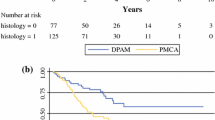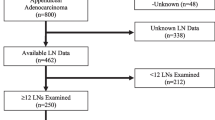ABSTRACT
Purpose
We evaluated the 7th edition of the American Joint Committee on Cancer (AJCC) staging classification in terms of overall survival (OS) in patients with PMP treated with cytoreductive surgery (CRS)/hyperthermic intraperitoneal chemotherapy (HIPEC).
Methods
A total of 208 PMP patients treated with CRS/HIPEC were identified from a prospective database. Patients with peritoneal mucinous carcinomatosis (PMCA) were retrospectively staged at time of diagnosis according to AJCC staging classification. Patients with disseminated peritoneal adenomucinosis (DPAM) were evaluated in a separate group.
Results
Median follow-up was 5.2 years. Of 208 patients, 124 had PMCA and 84 patients had DPAM. According to the AJCC staging classification 47 lymph node (LN) negative patients with well-differentiated PMCA, were classified as a stage IVA. 77 patients with either moderately or poorly differentiated PMCA irrespective of LN status, or well-differentiated PMCA with positive LN were classified as stage IVB. 84 patients with DPAM, constituted a separate group. OS of stage IVA and IVB patients was 100, 90, 67, and 91, 50, and 27 for 1, 3, and 5 years, respectively (p < 0.001). OS of DPAM patients was 96, 90, and 88 % for 1, 3, and 5 years, respectively (p = 0.025 comparing to IVA). PFS was estimated for IVA and IVB PMCA patients who were considered disease free after CRS/HIPEC and was 78, 52, and 43 % in the IVA patients and 65 %, 15 %, and 0 in the IVB group at 1, 3, and 5 years, respectively (p = 0.004). The adjusted HR for AJCC stages (IVA/IVB) was 3.7 (95 % confidence interval 2.0–6.7) (p < 0.001).
Conclusions
The 7th edition of the AJCC staging classification is a simple, reproducible, and valid classification for staging patients with PMCA undergoing CRS/HIPEC.


Similar content being viewed by others
References
Bradley RF, Stewart JH, Russell GB, Levine EA, Geisinger KR. Pseudomyxoma peritonei of appendiceal origin: a clinicopathologic analysis of 101 patients uniformly treated at a single institution, with literature review. Am J Surg Pathol. 2006;30:551–9.
Chua TC, Moran BJ, Sugarbaker PH, et al. Early- and long-term outcome data of patients with pseudomyxoma peritonei from appendiceal origin treated by a strategy of cytoreductive surgery and hyperthermic intraperitoneal chemotherapy. J Clin Oncol. 2012;30:2449–56.
Ronnett BM, Zahn CM, Kurman RJ, Kass ME, Sugarbaker PH, Shmookler BM. Disseminated peritoneal adenomucinosis and peritoneal mucinous carcinomatosis. A clinicopathologic analysis of 109 cases with emphasis on distinguishing pathologic features, site of origin, prognosis, and relationship to “pseudomyxoma peritonei.” Am J Surg Pathol. 1995;19:1390–408.
Shetty S, Natarajan B, Thomas P, Govindarajan V, Sharma P, Loggie B. Proposed classification of pseudomyxoma peritonei: influence of signet ring cells on survival. Am Surg. 2013;79:1171–6.
Andreasson H, Wanders A, Sun XF, et al. Histopathological classification of pseudomyxoma peritonei and the prognostic importance of PINCH protein. Anticancer Res. 2012;32:1443–8.
Carr NJ, Finch J, Ilesley IC, et al. Pathology and prognosis in pseudomyxoma peritonei: a review of 274 cases. J Clin Pathol. 2012;65:919–23.
Edge SB, Byrd DR, Compton CC, Fritz AG, Greene FL, Trotti A. AJCC cancer staging manual. 7th ed. New York: Springer; 2010.
Jacquet P, Sugarbaker PH. Clinical research methodologies in diagnosis and staging of patients with peritoneal carcinomatosis. Cancer Treat Res. 1996;82:359–74.
Elias D, Gilly F, Quenet F, et al. Pseudomyxoma peritonei: a French multicentric study of 301 patients treated with cytoreductive surgery and intraperitoneal chemotherapy. Eur J Surg Oncol. 2010;36:456–62.
Esquivel J, Sugarbaker PH. Second-look surgery in patients with peritoneal dissemination from appendiceal malignancy: analysis of prognostic factors in 98 patients. Ann Surg. 2001;234:198–205.
Shankar S, Ledakis P, El Halabi, Gushchin V, Sardi A. Neoplasms of the appendix: current treatment guidelines. Hematol Oncol Clin N Am. 2012;26:1261–90.
Sugarbaker PH. Epithelial appendiceal neoplasms. Cancer J. 2009;15:225–35.
Omohwo C, Nieroda CA, Studeman KD, et al. Complete cytoreduction offers longterm survival in patients with peritoneal carcinomatosis from appendiceal tumors of unfavorable histology. J Am Coll Surg. 2009;209:308–12.
Smeenk RM, Verwaal VJ, Antonini N, Zoetmulder FA. Survival analysis of pseudomyxoma peritonei patients treated by cytoreductive surgery and hyperthermic intraperitoneal chemotherapy. Ann Surg. 2007;245:104–9.
Arjona-Sanchez A, Munoz-Casares FC, Casado-Adam A, et al. Outcome of patients with aggressive pseudomyxoma peritonei treated by cytoreductive surgery and intraperitoneal chemotherapy. World J Surg. 2013;37:1263–70.
Halabi HE, Gushchin V, Francis J, et al. Prognostic significance of lymph node metastases in patients with high-grade appendiceal cancer. Ann Surg Oncol. 2012;19:122–5.
El Halabi, Gushchin V, Francis J, et al. The role of cytoreductive surgery and heated intraperitoneal chemotherapy (CRS/HIPEC) in patients with high-grade appendiceal carcinoma and extensive peritoneal carcinomatosis. Ann Surg Oncol. 2012;19:110–4.
Sugarbaker PH, Chang D. Results of treatment of 385 patients with peritoneal surface spread of appendiceal malignancy. Ann Surg Oncol. 1999;6:727–31.
Ronnett BM. Pseudomyxoma peritonei: a rose by any other name. Am J Surg Pathol. 2006;30:1483–4.
Pai RK, Beck AH, Norton JA, Longacre TA. Appendiceal mucinous neoplasms: clinicopathologic study of 116 cases with analysis of factors predicting recurrence. Am J Surg Pathol. 2009;33:1425–39.
Misdraji J. Appendiceal mucinous neoplasms: controversial issues. Arch Pathol Lab Med. 2010;134:864–70.
Carr NJ, McCarthy WF, Sobin LH. Epithelial noncarcinoid tumors and tumor-like lesions of the appendix. A clinicopathologic study of 184 patients with a multivariate analysis of prognostic factors. Cancer. 1995;75:757–68.
Gibbs NM. Mucinous cystadenoma and cystadenocarcinoma of the vermiform appendix with particular reference to mucocele and pseudomyxoma peritonei. J Clin Pathol. 1973;26:413–21.
Higa E, Rosai J, Pizzimbono CA, Wise L. Mucosal hyperplasia, mucinous cystadenoma, and mucinous cystadenocarcinoma of the appendix. A re-evaluation of appendiceal “mucocele.” Cancer. 1973;32:1525–41.
Melcher DH, Rayan AS. Columnar-cell (non-carcinoid) tumours of the appendix. Br J Surg. 1968;55:693–6.
Misdraji J, Yantiss RK, Graeme-Cook FM, Balis UJ, Young RH. Appendiceal mucinous neoplasms: a clinicopathologic analysis of 107 cases. Am J Surg Pathol. 2003;27:1089–103.
Woodruff R, McDonald JR. Benign and malignant cystic tumors of the appendix. Surg Gynecol Obstet. 1940;71:750–5.
Disclosure
The authors declare no conflict of interest.
Author information
Authors and Affiliations
Corresponding author
Rights and permissions
About this article
Cite this article
Milovanov, V., Sardi, A., Studeman, K. et al. The 7th Edition of the AJCC Staging Classification Correlates with Biologic Behavior of Mucinous Appendiceal Tumor with Peritoneal Metastases Treated with Cytoreductive Surgery and Hyperthermic Intraperitoneal Chemotherapy (CRS/HIPEC). Ann Surg Oncol 23, 1928–1933 (2016). https://doi.org/10.1245/s10434-015-5047-5
Received:
Published:
Issue Date:
DOI: https://doi.org/10.1245/s10434-015-5047-5




